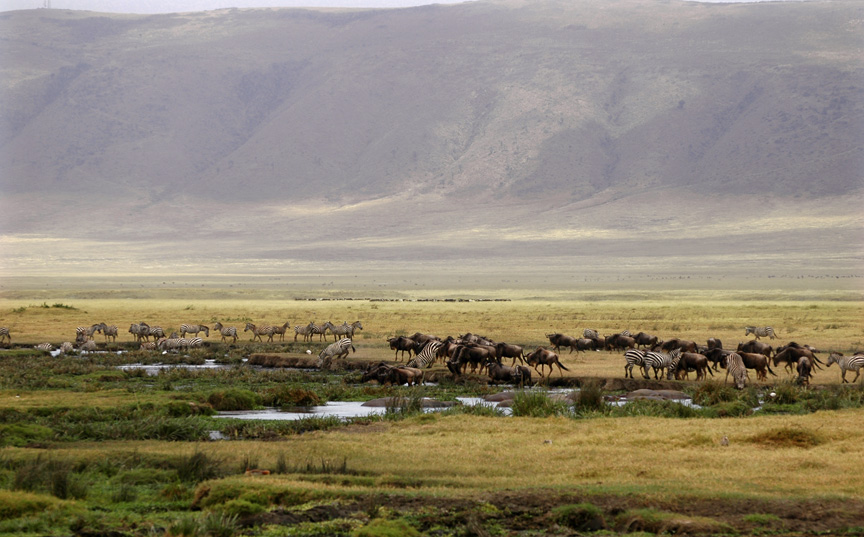"It is such a captivating and breathtaking phenomenon. It is impossible to give a fair description of the crater. There is nothing with which to compare. It is one of the wonders of the world..." - Professor Bernard Grzimek

The Ngorongoro Crater
It is possible to see all BIG five Animals of Africa in a single day, crater is the most impressive
geological feature in Africa.The crater is also a major traffic hotspot, with hundreds of vehicles visiting daily
in high season. We therefore tend to recommend that visitors treat the crater as a great place to spend a half day
driving through on the way north to the Serengeti.
The Ngorongoro Crater, at 2286 meters above sea level, is the largest unbroken caldera in the world.
Surrounded by sheer walls rising 610 meters from the crater floor, this natural 259 sq. km amphitheater provides
a concert of life for all species.
Ngorongoro Conservation Area boasts of the finest blend of landscapes, wildlife, people and archeological sites in the world. It is also a pioneering experiment in multiple land use. For NCA, the concept means making the best use of the resources to achieve the basic objectives of the NCA. This entails the management and utilization of resources in the form for which the are best suited based on biological productivity and pertinent social and economic factors.
On the floor of this "Garden of Eden" roam over 20,000 large animals including some of Tanzania's last remaining black rhino. Animals are free to leave or enter the crater but most of them stay because of the plentiful water and food available on the crater floor throughout the year. Other species are mainly wildebeest, zebra, buffalo and gazelles. All these animals in turn support large predators such as lions and leopard, and scavengers such as hyena and jackals. More than a hundred species of birds reside within NCA including: ostriches, kori bustards, secretary birds, crested cranes, egrets, red-billed ox-peckers and countless flamingos forming a pink blanket over the soda lake.
Olduvai Gorge
Between the great wildlife sanctuaries of Ngorongoro Crater and Serengeti lies Olduvai Gorge. The "cradle of man", as this stone-age site is popularly known, is where the skull of the "Nutcracker Man" (Zinjathropus bisei) was unearthed by Prof. Louis Leakey in 1959. Nearby is Laetoli where the footprints of humanoids (said to be 3.5 million years old) were discovered by Mrs. Mary Leakey in 1979.
Oldonyo Lengai
Oldonyo Lengai located north of ngorongoro crater, a living volcano. Around these sites of man's origin teem millions of wild animals. Archaeological work is still going on in this area. The theory exists that Homo sapiens originated in Africa and Olduvai Gorge provides the evidence.
Best time to visit Ngorongoro
Best time to go: June to September for general wildlife viewing
High Season: Most of the year - July to March (Crater will have crowds)
Best Weather: June to October (Rainfall is little to none)
Worst Weather: March and April (Peak of wet season)
Activities at Ngorongoro
Walking Safari Crater Highland
Game Drivers
Oldonyoi Lengai located at the Boarder of (NCA) Conservation area close to Lake Natron
Special treks are available via Olmoti Crater, Embakai Crater and to Lake Natron end trek at lake Natron with option of climb Active volcanic Mountain Oldonyoi Lengai.
For more information,

